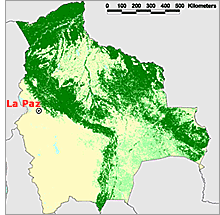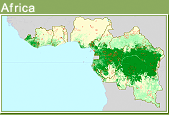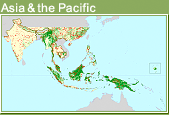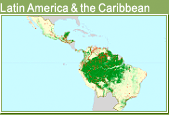Country details
Status of Tropical Forest Management 2005
Latin America & the Caribbean
Bolivia

©UNEP-WCMC 2004
Bolivia has made remarkable progress towards SFM over the past decade. It has launched and implemented a comprehensive and ambitious reform of its forest sector and embarked on a major process of conferring property rights for natural forests to indigenous communities. Through an overarching political decentralization process, responsibilities and monitoring functions are being decentralized to municipalities and rural communities; this has generated some tensions. Forest certification has become a major factor in the introduction of SFM practices, and Bolivia has the largest area of certified natural forest in Latin America. However, the reform process faces many obstacles; full implementation still needs time and continuous and strong political will.
Key points
- The PFE comprises an estimated 17.0 million hectares of production forest and 14.7 million hectares of protection forest. A further 16.3 million hectares of forest have not yet been allocated.
- There remain huge, partly unexploited forest resources in the Amazon Basin.
- The estimated area of natural-forest production PFE under sustainable management is at least 2.18 million hectares; the estimated area of protection PFE so managed is at least 2.38 million hectares.
- The Ministry of Sustainable Development and Planning has overall responsibility for the national forestry regime.
- The Forestry Superintendency oversees adherence to the forest law.
- Territorial grassroots organizations are gaining increasing recognition in the new structure for the use of forest resources, but tensions remain.
- A well-established wood-processing industry, good professional knowledge and the establishment of certified forests provide a good basis for SFM. But access to some markets for certified timber remains problematic and the lack of a significant price premium may make it difficult to maintain high standards.
- An auditing system is in place; as it becomes operational, a clearer picture of the overall situation in production forests will emerge.
- Land tenure and, in particular, the absence of clearly defined property rights are key limitations to attracting investments to the Bolivian forest sector and, consequently, to achieving SFM.
- There are ambitious plans for the creation and management of protected areas, but these still need to be acted upon. The status of their management is mostly unclear.
- Illegal logging and illegal crops are constraints to the full adoption of SFM and the effective conservation of protected areas in many localities.

 Africa
Africa  Asia & the Pacific
Asia & the Pacific  Latin America & the Caribbean
Latin America & the Caribbean